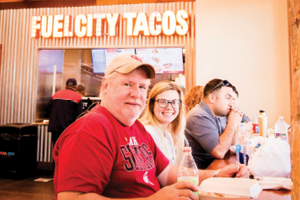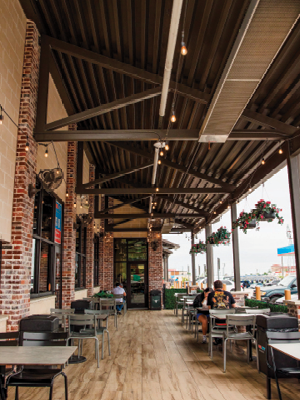Convenience stores continue to become major destinations for consumers in search of top-notch food and drinks. At some stores, like Fuel City in Texas, amenities such as comfortable indoor and outdoor seating areas—complete with heaters and fans—have taken the c-store dining experience to a whole new level.
“We recently hosted a wedding rehearsal dinner on the patio of our Wylie store for a bride who loves our tacos,” said Fuel City CEO Joseph Bickham. With a growler bar and the ability to seat up to 30 guests inside and another 30 outside, the store “has a fun atmosphere,” Bickham explained. “Guests like to stay and hang out.”
Indeed, as c-stores have evolved, seating has become more common. Since opening its first store in Plymouth, Massachusetts, five years ago, Global Partners’ Alltown Fresh concept has installed both indoor and outdoor seating where it can.
According to Kristin Menconi, senior retail marketing manager, “Alltown Fresh guests enjoy being able to sit down and relax at our locations.” All 16 units offer some interior seating space and 11 have outdoor seating. “Our locations are in New England, so once the warmer months arrive, guests very much appreciate our outdoor areas. It’s a unique attribute to offer both indoor and outdoor seating at convenience stores,” she said, and the retailer plans to continue the option at all stores moving forward.
Across the country in Seattle, two-unit Cone & Steiner has had indoor and outdoor seating “from day one,” owner Dani Cone said. “We designed the stores to include indoor and outdoor seating as we serve beer, wine, coffee and food items.”
For a small corkage fee, customers can drink their purchased alcoholic beverages on-site, Cone explained. “Having seating is an important part of our model, and we intentionally designed the stores to have a ‘third-place’ component.”
 “Guests like to stay and hang out” at Fuel City locations.
“Guests like to stay and hang out” at Fuel City locations.
With stores in Maine, New Hampshire, Massachusetts and Rhode Island, Rusty Lantern Markets is another c-store operator that has offered both indoor and outdoor seating since its inception. “We wanted to give our customers a place to sit and relax while they enjoyed a meal or cup of coffee, to meet with friends in the morning, grab a quick bite for lunch or dinner, or to stop for a bite while they worked,” explained John Koch, manager and CEO of the chain.
With seating that can accommodate up to 25 guests, Rusty Lantern’s seated spaces include stone-faced indoor and outdoor fireplaces, table and lounge-chair seating options, and firepit table seating with Adirondack-style chairs. “Seats are regularly occupied and people appear to be enjoying themselves,” Koch said.
The ‘Third Place’
“Starbucks popularized the ‘third place,’ with lots of seating options years ago,” remarked Joseph Bona, president, Bona Design Lab, a retail design consulting firm. “As foodservice in c-stores continues to get better and better, in-store seating could become a bigger consideration.”
But operators need to be aware of other trends before investing heavily in seating. Quick-service restaurants are serving more consumers via drive-thrus these days than in store, so for them, “seating isn’t as important as it once was,” Bona said. At the same time, some convenience retailers don’t want to infringe on valuable parking space. “Operators must figure out the right balance for offerings, including parking and in-store seating,” Bona advised.
Austin Burns, director of sales and marketing at Paragon Solutions, a retail design firm that specializes in c-stores, added that food offerings should lead the consideration of customer seating. Signature items that may require two hands to consume warrant seating, he explained. Fuel City’s tacos, for example, lend themselves to a seated-dining experience. “We’re a food-forward concept,” said Bickham, “so it makes sense to have seating. Customers don’t feel like they’re at a convenience store.”
Customers don’t feel like they’re at a convenience store.”
The situation is much the same at Rusty Lantern. “Having freshly made food and specialty drinks encourages people to stay on-site,” explained Koch, pointing to items like Rusty Lantern’s fresh-made lobster rolls, lobster mac-and-cheese, lobster salad and lobster quesadillas.
For some c-stores, outside seating can be more attractive than in-store, possibly because it’s a smaller investment, noted Bona. “If there’s an underutilized area that can’t be used for parking, why not?” he asked. “A few tables, chairs and umbrellas are all that’s needed.” He and Burns agreed that if the outdoor space is attractive, it can provide a halo effect on a c-store. “Outdoor tables signal on the outside that there’s something to eat on the inside,” Bona said.
But outdoor seating can provide several challenges for c-stores. Weather, safety and maintenance can be drawbacks for outside seating, according to Mike Hamzeh, general manager at one of the two Duke’s Travel Plaza locations in Texas, which offer both indoor and outdoor seating. “Weather conditions—heat, cold, rain or snow—affect customer comfort,” he explained, so the spaces may see limited usage. “Maintenance and upkeep of outdoor furniture and facilities” is also necessary, Hamzeh said, as is “ensuring safety and security for customers in an outdoor setting.”
Loyalty Builder
Whether the seating is outside or inside, c-store operators agree that the amenity helps provide a pleasant experience for customers and can draw them back again. “Our seating gives people a place to meet up with friends or business associates,” said Rusty Lantern’s Koch. “The seating lends itself to the social experience—get out into the community, grab a cup of coffee or visit with neighbors.”
At Duke’s, meanwhile, with seating for more than 80 customers in its food court, “climate-controlled seating areas provide a comfortable escape from extreme weather conditions,” Hamzeh noted. In addition to free Wi-Fi, Duke’s Travel Plazas also feature charging stations and entertainment options for customers.
The benefits of seating for c-stores range from larger basket spends to competitive advantages and enhanced customer loyalty. “Customers stay longer, so it expands the basket,” remarked Fuel City’s Bickham. He added that seating can also boost a daypart, such as the evening hours, when traffic might otherwise be slow.
 Fuel City offers indoor and outdoor seating.
Fuel City offers indoor and outdoor seating.
“Offering indoor seating sets our business apart from competitors,” noted Duke’s Hamzeh, “making it a preferred stop for travelers.” Seating is also a way to show a level of commitment for customers and to build loyalty. “Providing a welcoming space fosters a positive impression, positive word-of-mouth support, and encourages loyalty and repeat visits,” he added.
But just as with outdoor seating, indoor seating comes with considerations. Bickham pointed to capital expenditures and the required space. “Every square foot must deliver, and with 2,000 square feet devoted to seating, it’s not directly generating revenue. You’re not selling anything within that space,” the Texas retailer noted. Bickham, Cone and Hamzeh all cited the maintenance and labor required to service dining areas of their stores. “We try to be lean and efficient with labor,” but indoor seating requires upkeep, Bickham said.
Hamzeh added that “the potential for loitering or disruptive behavior” can also be a challenge of c-store seating. Indeed, according to Bona, some c-store operators are “anti-seating. They don’t want people lounging. They don’t want to have to worry about tables turning, but rather parking spots turning.”
Food for Thought
For c-store operators who may be considering customer seating, Bona and Burns agree that it’s best to include seating with a new store build instead of adding it later. “Don’t look at it as an adjunct, such as if you have dead space in the store and decide to add a few tables,” Bona said. Rather, the design should be thought out. “It doesn’t have to be Starbucks, but the seating should be thoughtful,” he advised. “Avoid having the seating in the middle of the space. You want the store to be the hero.”
When it comes to furniture, Bona suggested, “give consumers options with different types of tables, both counter height and bar-top height, as well as the ability to add chairs to a table.”
Consider what your brand statement is.”
He also said retailers should consider adding outlets to power devices, and only use commercial-grade furniture, “not furniture meant for the home. It needs to stand up to abuse.” For that reason, he recommends against using fabrics, but rather materials that are easy to clean. For example, Bona noted that vinyl seat coverings are good for seating areas due to their cleanability and durability, and they also come in wide variety of colors and patterns.
The two design experts also agree that lighting in the space can’t be an afterthought. “Lighting is a part of the ambiance,” said Bona. “You don’t want cafeteria grade. You want people to be able to feel relaxed.”
Most importantly, the decision to include customer seating must complement the brand. “Consider what your brand statement is,” said Burns. “What do your customer demographics suggest? How do you differentiate from the competition?”
Indoor and outdoor seating may not work for all c-stores. “Stay true to your brand,” Burns said. “Don’t force it if it doesn’t make sense.”